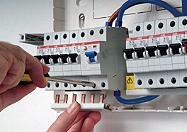Our Voltimum Experts answer your questions on a daily basis in our Technical Expertise area. This one, regarding isolation by removing the main fuse at the origin of an electrical installation, is answered by the ECA:

I understand that the main switch in the consumer unit (CU) should be locked-off to safely isolate the supply, but what if I need to replace the main switch or, perhaps, replace the consumer unit? This would involve removing the main fuse - yet this appears to be a problem in the eyes of the electricity distributor (according to the first paragraph on page 17 of the On-Site guide, i.e. cut-out sealed off).
So, if it is illegal for me to remove the main fuse, why is it not a legal requirement for the distributor to provide an isolating switch between the main fuse and the consumer unit for every electrical installation (such as the example shown on pages 15-16 of the On-Site Guide)?
It must surely be inconvenient and time consuming for any electrician to go through the hassle of contacting the distributor to just to arrange the simple removal of the main fuse.
And what about working near live parts? For example, if I have to remove the consumer unit cover to access final circuit conductors to carry out, say, testing procedures (e.g. cross connections for ring circuit continuity tests), this would involve working near the Line and Neutral supply conductors, which are live despite the fact that the main switch in the consumer unit is locked-off. Furthermore, any dead disconnected final circuit conductors in the consumer unit could make contact with the supply conductors and become live because of their close proximity within the consumer unit.
Surely, when working inside a consumer unit, the safest method of isolation in this situation is to remove the main fuse?
Answer: For the time being, if there is no isolator between the cut-out and the consumer unit, the supplier has to be requested to provide isolation - if necessary. If you are carrying out ring circuit continuity testing, for example, then you as a competent person would isolate the circuit by turning off the main switch on the consumer unit. You could then carry out your tests after proving dead.
The live parts on the main switch should be protected to at least IP2X to prevent danger.
To see many more Q & A in Voltimum UK's Experts Area, please click on the link:
www.voltimum.co.uk/consult.php?universe=consult.index.questions